Houzz Tour: Meet the Schoolhouse Saved By ‘The Birds’
http://decor-ideas.org 10/31/2014 01:13 Decor Ideas
The frightening movie scene is familiar to people around the world: After a string of strange and increasingly violent bird attacks, Melanie Daniels (Tippi Hedren) goes to the local school to fetch Cathy (Veronica Cartwright), the young sister of her love interest, Mitch Brenner (Rod Taylor). As she approaches the stately white building, you hear children’s voices piping the haunting Scottish song “Wee Cooper O’Fife,” with its mewling refrain of what sounds like “now, now, now.” As Daniels waits for the appropriate moment to interrupt class, she smokes a cigarette on a bench outside. Behind her we notice a large flock (or, to use the correct term, murder) of crows gathering on the monkey bars in the play yard.
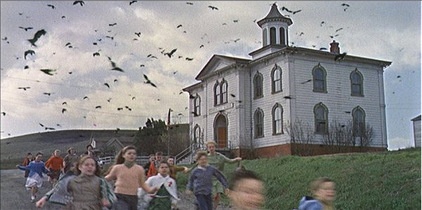
After what seems like a tense eternity, she finally sees them and goes into the school to warn the teacher, her frenemy Annie Hayworth (Suzanne Pleshette). Hayworth calmly gathers the children and has them evacuate the school. As they start to run, the crows spring into action in an attack scene as chilling today as it was when committed to film in 1962.
Saved by “The Birds”
For the characters in the movie, particularly Hayworth, things get a whole lot worse from there. But for the schoolhouse, things were about to get better.
According to its current owner, The Birds saved the 141-year-old edifice. Leah Taylor’s family has owned it since 1966, and how they restored the structure, maintained it over the past 48 years and endured a list of unexplained happenings is a testament to the power old buildings exert on some of us.
This still from the movie shows the schoolhouse on a small rise among the rolling hills of Bodega, California — a small town on the way to the coastal hamlet of Bodega Bay.
In the movie it’s called The Bodega Bay School, although its namesake is some 7 miles down the road. In this scene the children (many of them were local kids hired as extras) have just been instructed to run at the teacher’s command, but they can’t outpace the malicious crows.
Photo: “The Birds,” Universal Studios
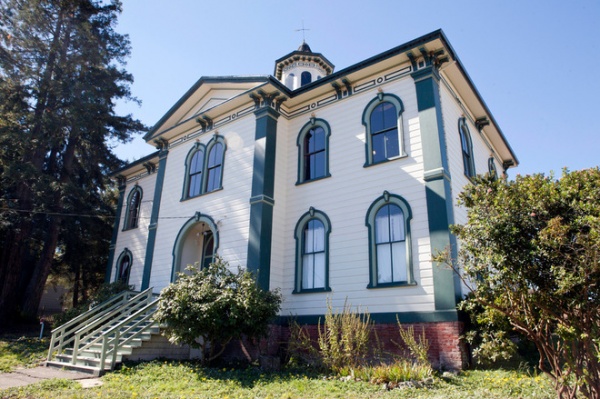
Photos by Joseph Schell and Andrew Todd
Houzz at a Glance
Who lives here: Leah Taylor and Rick Williams
Location: Bodega, California
Year renovated: First renovation in 1966
Size: 6,000 square feet (557 square meters)
Before Hitchcock discovered the building, it had been shuttered for four years. “The last class was in 1959,” says Taylor. “It needed retrofitting that the city couldn’t pay for. It just didn’t make sense to keep it open.”
Taylor speculates that Hitchcock discovered the schoolhouse while filming Shadow of a Doubt in nearby Santa Rosa. “I imagine he went to the beach at some point,” she says. “Who comes out here and doesn’t go to the beach?”
In fact, that’s how her parents, Tom and Mary Taylor, found it — while driving by to take Leah and two brothers to swim in the ocean. One Sunday they stopped, after her mother had spotted a notice in the Santa Rosa Press Democrat advertising the school for sale. “They were not moviegoers, and they had not seen The Birds,” she says. “My mother simply loved the building and wanted to fix it up and live there.”
Today Mary Taylor’s infatuation is understandable, as the years have done little to diminish the beauty of what was surely among the grandest buildings in town when it was built as a school and the community center in 1873.
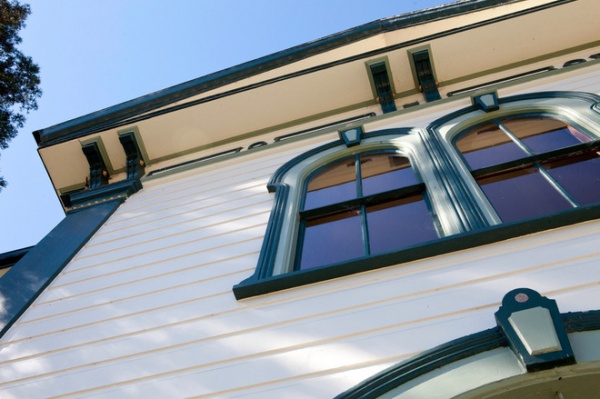
The building had fallen far since its glory days as the center of community life in Bodega. When it was constructed, the town was a thriving mill center. “There were five sawmills, five hotels and five saloons here. There were also two churches and a Druids Hall,” Taylor says.
“No one ever found any gold in these hills, but the trees were the gold that made some people rich. They built the schoolhouse out of the virgin old-growth redwoods and named it Potter School, after Samuel Potter, who donated the land.”
Over the years the area was logged out, and the population dwindled dramatically. What had once been a bustling lumber town became a sleepier center for the dairy farms springing up around it. In addition to the need for retrofitting, the number of children had dwindled to eight before the city shut down the school and sold it.
“The man who bought it was going to dismantle it and sell the lumber,” says Taylor. “But Alfred Hitchcock rented it just in time. After that I think the owner recognized it had some historic value and decided to sell it rather than tear it down. So I tell people the movie saved it.”
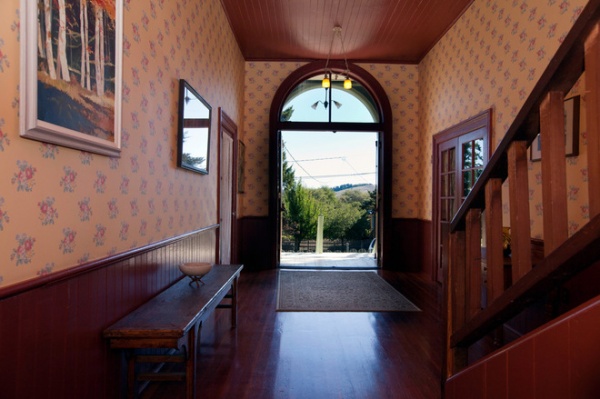
Perhaps the movie did, but it was the Taylor family who brought the place back to life.
When they first toured the Italianate structure, it was at its lowest point and seemed completely impractical. “There were holes in the roof, and, ironically, birds had taken over the second story,” says Taylor. “There was about 2 feet of bird droppings up there, which was hard to reach because the city had removed the unstable interior staircase. The film crew had left it a mess; there were old film canisters and trash everywhere. The place had no water, no electricity, no kitchen.”
Leah Taylor was 11 when the family started working on it. “In my memory we were up here every single weekend doing something to it. As a child it wasn’t fun for me.”
Relics of the School’s Past
As they worked, the family took great care to preserve and restore what was there. “There are places where kids carved their names into the walls,” Taylor says. “We left them, as my mom considered it part of the history of the school. Today some of the boys who did that are grown men who live in the community.”
Originally there were two classrooms: one for grades 1 to 4 and one for grades 5 to 8. “At that time there was nothing in town beyond that,” Taylor says. “I think if you made it to eighth grade back in 1873, you were doing great.”
Today one classroom is the guest suite and the other is a family room.
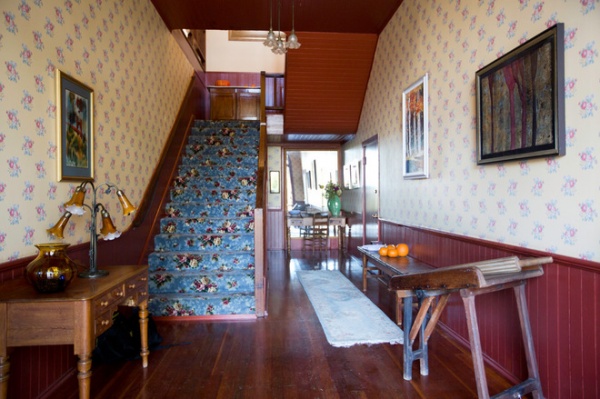
“One of the first things we did was rebuild the staircase,” says Taylor. “Before, you had to get up there on a rickety exterior stairway.”
Taylor has stuck with furnishings and finishes that look right for the building’s era. “I love modern things, but they just wouldn’t look right here,” she says.
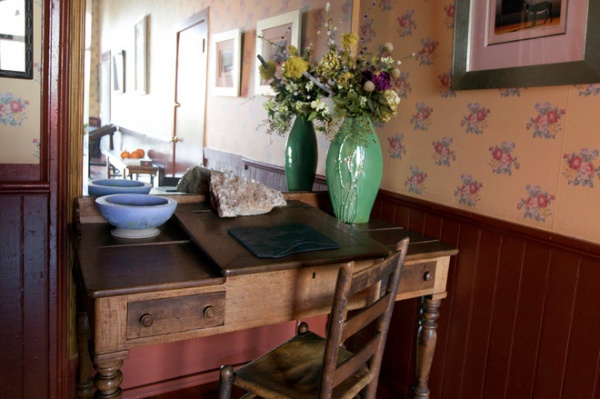
One of the great discoveries was an original teacher’s desk. It was in bad shape, but the family refinished it. Today it sits in the long entry hall.
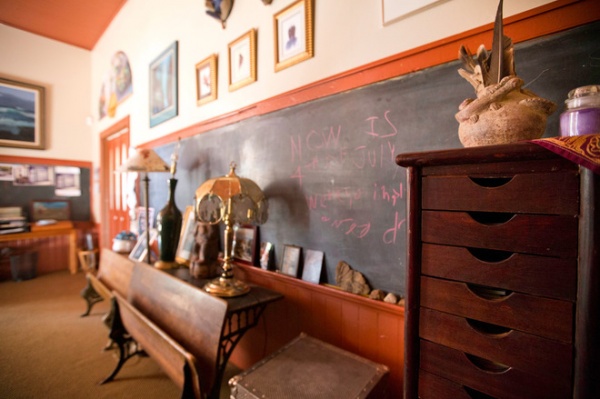
The desk was one of the few things left when the family took on the place. “After it was closed, people came in and took desks and mementos,” Taylor says. “I think that many of them where trying to preserve a piece of the town’s history, because as we fixed up the place, they would bring the items back and give them to us.” In what is now the family room, a row of the original desks and chairs sits under the chalkboard.
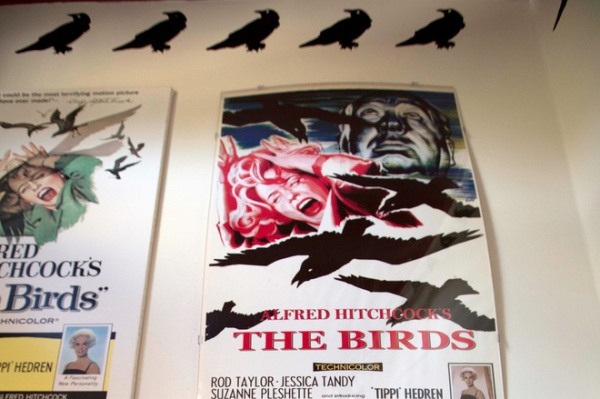
This movie poster is part of a small collection of historic schoolhouse-related items that Taylor has amassed. It lives in one of the former classrooms Hitchcock chose to film. In a tongue-in-cheek decorating move, Taylor chose a stenciled crow border for what is now a guest suite.
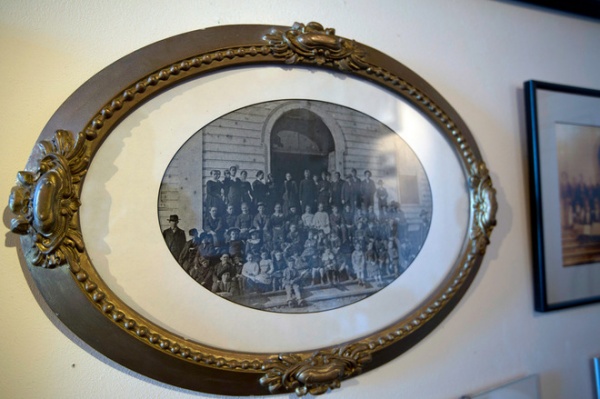
A photo of a bygone class is another relic.
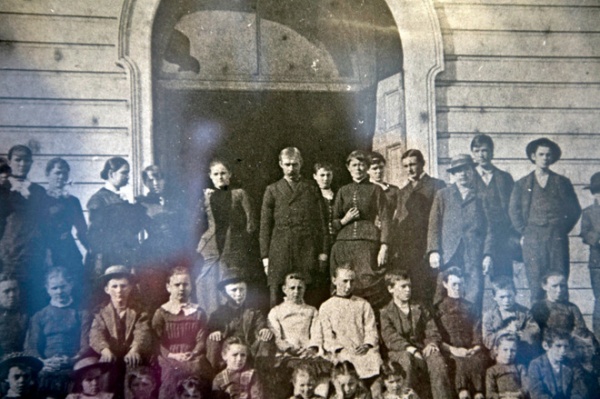
In the center of the shot is teacher Calvin Keithly. The photo was taken at the turn of the century, but some people think the teacher is still around. A tourist snapping a photo in front of the school captured what appears to Taylor to be his ghostly figure in the second-story window.
You see, Hitchcock’s movie isn’t the only spooky thing associated with the building. Keithly’s visage is just the latest of a long list of strange happenings the family has experienced. It all started on their first morning in the house.
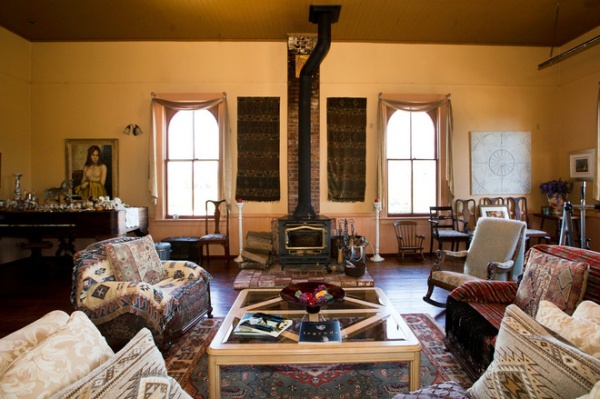
It happened in the large room upstairs, where the family had camped out in sleeping bags around the woodstove. “My father got up the next morning, and he heard a voice say clearly and brightly, ‘It’s Sunday morning!’” says Taylor.
“The second floor of the schoolhouse was where the community had dances, debates and presentations,” she says. (Today it is the living room and dining room.) “Something about gatherings and parties seems to make them active.”
By “them,” Taylor means ghosts. She says she’s seen and felt a number of strange things — including a levitating little girl who offered her a reverberating “hi” by way of a greeting. Most often she sees what looks like heat shimmers that come off asphalt in the summer. She says they move quickly across the room, diminishing in size. But don’t take her word for it; the Office of Scientific Investigation and Research declared the place an official haunted spot in 1994.
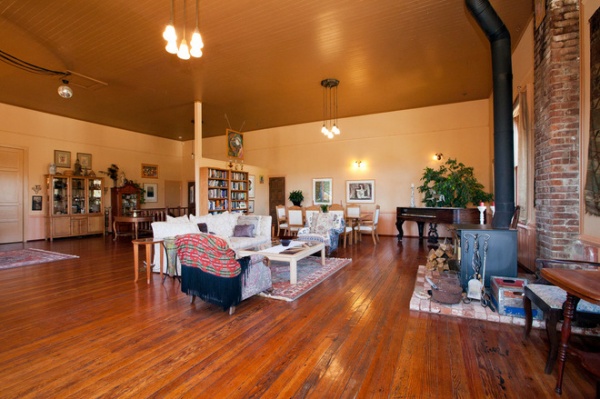
That designation brought the house another shot of fame, as it was featured on a television show about haunted spots in America. Taylor says she’s accustomed to her home being noticed.
“You would think that everything would have died down by now,” she says. “In fact, it’s the opposite. Right after my parents bought it, the attention wasn’t very bad, but it seems to be growing. I think it’s because everyone has a television and the movie is easily accessible. All over the world, people know this place.”
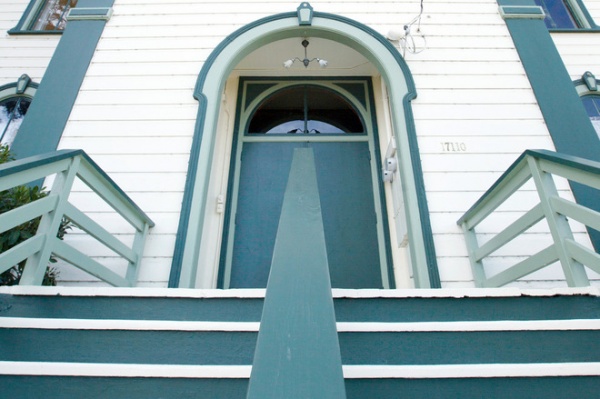
“It is like living in a fishbowl,” she says. “A few years ago, we had some drunk people come up and pound on the door in the middle of the night. After that I built a fence around the property.” Taylor put up a sign on that fence that briefly describes the history of the building. “We avoid going in the front yard,” she says. “We get a lot of people calling questions over the gate.”
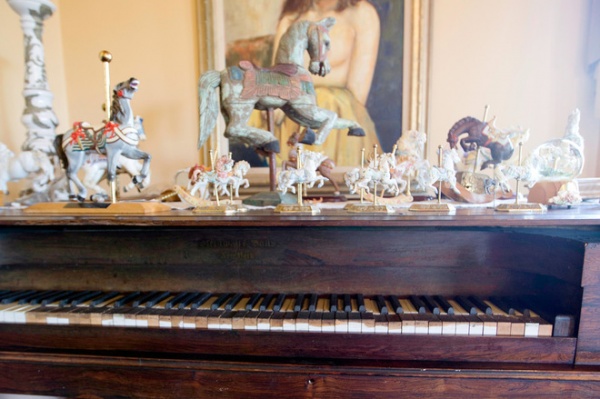
However, Taylor does open the doors and give tours occasionally to benefit charity. (And when she does, this piano that was purchased for the building when it was built is usually featured.) “My parents believed in having the building accessible so people could enjoy it, and I guess the apple really doesn’t fall far from the tree,” she says. “It also helped it pay for itself.” Over the years the former school has been home to an art gallery and a restaurant, and the scene of plays that Taylor, a performer and a dramatist, has staged.
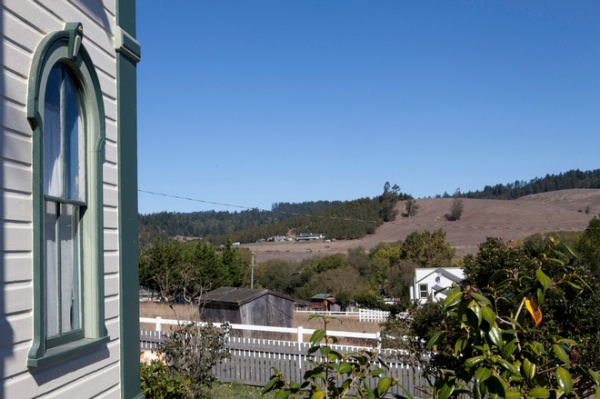
When asked about the headache of living in a often-recognized and much-photographed building, Taylor says: “I’m used to it, so it really doesn’t bother me. Sure, there are inconveniences, but there are also great benefits to living here. If you want to see them, just look out the window.”
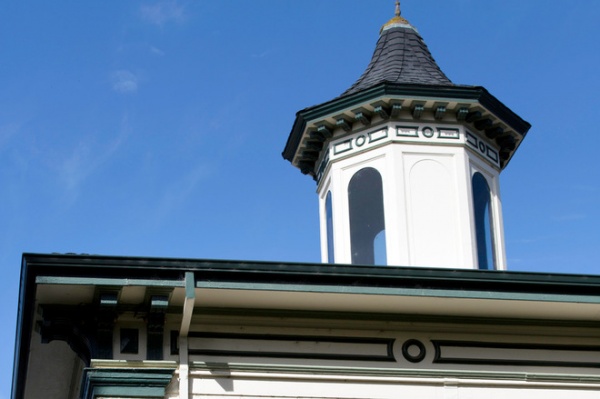
Although the building’s fame calls people today, Taylor says that the cupola at the top of the building used to hold a bell that would summon children to school and townspeople to events. She’s not sure what will be the draw for its next chapter. “I know my son doesn’t want to live here,” she says with a laugh. He may be in the minority, because, like the mythical bell that can’t be unrung, interest in the schoolhouse doesn’t seem to go away.
More: Tour Fred MacMurray’s Enduring Farmhouse Retreat
Related Articles Recommended












